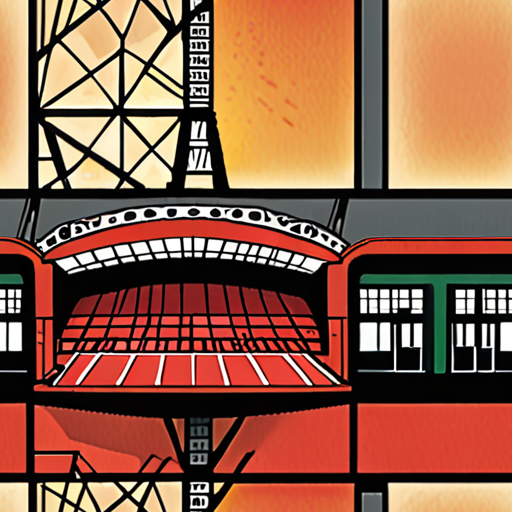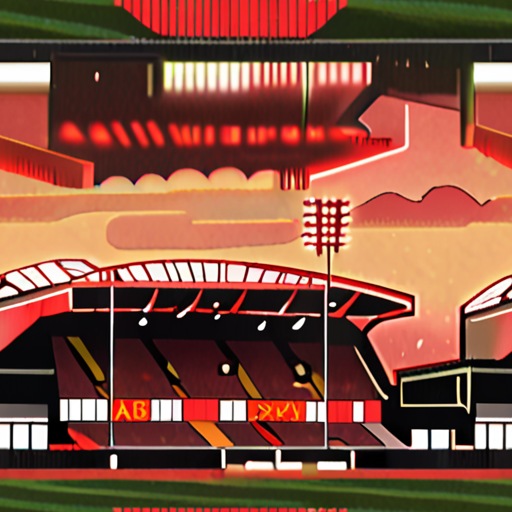When it comes to English football, few stadiums evoke the same level of passion and intensity as Anfield, the iconic home of Liverpool Football Club. For decades, the Reds have dominated at their beloved stadium, leaving fans and opponents alike wondering what secrets lie behind their remarkable success. At the heart of this phenomenon lies the tactical genius of Jürgen Klopp, whose innovative approach to the game has transformed Liverpool into one of the world’s top teams.

Unpacking Anfield Tactical Reports: A Deep Dive into Liverpool’s Home Stadium Strategies
We’re proud to share our expertise on how Liverpool’s tactics typically unfold when playing at their iconic home stadium, Anfield.
- The Reds have consistently demonstrated a strong attacking style, often employing a high-intensity press to win the ball back quickly and catch opponents off guard.
- Liverpool’s midfield trio, comprising Fabinho, Jordan Henderson, and Thiago Alcantara, plays a crucial role in controlling the tempo of the game and distributing the ball effectively to the forwards.
- Anfield’s intimidating atmosphere and compact pitch dimensions allow Liverpool to adopt a more direct approach, often bypassing midfield and launching swift counter-attacks down the flanks.
- The team’s reliance on set pieces, particularly corners and free kicks, has been a significant factor in their home successes, with players like Virgil van Dijk and Mohamed Salah frequently scoring crucial goals from these situations.
- Liverpool’s ability to adapt their tactics mid-game, often switching between a 4-3-3 and 4-2-3-1 formation, has proven effective in exploiting opponents’ weaknesses and capitalizing on opportunities.
- The Reds’ impressive home record can be attributed to their exceptional defensive solidity, with goalkeeper Alisson Becker and his backline consistently making crucial saves and blocks to protect the lead.
- Anfield’s passionate crowd and electric atmosphere play a significant role in motivating the team, with the Reds often feeding off the energy of the fans to deliver outstanding performances.
- Liverpool’s commitment to developing young talent and promoting a culture of excellence within the club has contributed significantly to their sustained success at Anfield.
- The team’s ability to rotate and manage their squad effectively, allowing key players to rest and recover, has helped maintain a consistent level of performance throughout the season.
- Anfield’s state-of-the-art facilities and training infrastructure provide the Reds with a competitive edge, enabling them to fine-tune their skills and prepare for matches with precision.
- Liverpool’s dedication to community engagement and outreach programs has fostered a strong bond between the team and their loyal fan base, further amplifying the electric atmosphere at Anfield.
In conclusion, Liverpool’s tactics at Anfield are characterized by a potent blend of attacking flair, defensive solidity, and adaptability, which has enabled the team to establish themselves as one of the premier forces in English football.
Unpacking Anfield’s Strengths: Key Factors Behind Liverpool’s Home Ground Success
We’ve delved into the world of tactical formations and analyzed the secrets behind Liverpool’s dominance at Anfield.
- Tactical Flexibility: Jürgen Klopp’s ability to adapt his tactics has been instrumental in Liverpool’s success. By switching between different formations, he can exploit opponents’ weaknesses and catch them off guard.
- High Pressing: Liverpool’s high-intensity pressing game has been a hallmark of their success at Anfield. This approach forces opponents to make mistakes, which can lead to scoring opportunities.
- Counter-Attacking: Liverpool’s quick transitions from defense to attack have caught many teams off guard. Their pace and agility allow them to capitalize on counter-attacking opportunities.
- Set Piece Expertise: Liverpool’s set pieces have been a crucial aspect of their success. They’ve consistently scored goals from dead-ball situations, often catching opponents off guard.
- Home Advantage: Anfield’s intimidating atmosphere plays a significant role in Liverpool’s success. The crowd’s energy and noise levels can unsettle opponents, making it difficult for them to perform at their best.
Liverpool’s success at Anfield can be attributed to a combination of these factors. By understanding and exploiting their opponents’ weaknesses, Klopp’s team has been able to dominate games and secure crucial victories.
In addition to these key factors, Liverpool’s squad depth and consistency have played a significant role in their success. The team’s ability to rotate players and maintain a high level of performance has been impressive, allowing them to sustain their title challenge.
As we continue to analyze Liverpool’s success, it’s clear that their home ground advantage is a significant factor. Anfield’s electric atmosphere and the team’s ability to adapt their tactics have made them a formidable force in English football.
By studying Liverpool’s approach and tactics, teams can gain valuable insights into how to improve their own performances. Whether it’s adopting a more flexible approach or focusing on set piece expertise, there are lessons to be learned from Liverpool’s success at Anfield.
The Reds’ ability to adapt and evolve has been a key factor in their success. As they continue to push for titles and trophies, it will be fascinating to see how they develop their tactics and approach to stay ahead of the competition.
With their rich history and passionate fan base, Liverpool remains one of the most exciting teams to watch in English football. As they continue to thrive at Anfield, it’s clear that their success is built on a foundation of hard work, dedication, and a willingness to innovate and adapt.

Unlocking Anfield Fury: Jürgen Klopp’s Tactical Adjustments
We’ve delved into the key adjustments that fuel Liverpool’s dominance over opponents and uncovered the strategies behind their home-field advantage.
-
Tactical Shifts at Anfield
Jürgen Klopp makes several tactical adjustments when playing at Anfield, which significantly impact Liverpool’s overall performance.
-
Formation Changes
Klopp often employs a 4-3-3 formation at Anfield, allowing for greater flexibility and control in midfield.
-
Pressing Intensity
The team presses high up the pitch, forcing opponents to make quick decisions and reducing their time on the ball.
-
Target Man Role
Liverpool’s target man plays a crucial role in holding up the ball and bringing others into play, creating opportunities for counter-attacks.
-
Winger Roles
The wingers are tasked with hugging the touchline, providing width and delivering crosses into the box.
-
-
Impact on Opponents
The tactical adjustments made by Klopp have a significant impact on opponents, making it difficult for them to gain a foothold in the game.
-
Reduced Possession Time
The intense pressing and midfield pressure reduce the time opponents have possession of the ball.
-
Increased Errors
The high-intensity pressing leads to increased errors among opponents, resulting in turnovers and scoring opportunities for Liverpool.
-
Difficulty in Creating Chances
Opponents struggle to create chances against Liverpool’s well-organized defense and midfield press.
-
-
Key Players Involved
A number of players contribute to Liverpool’s success at Anfield, including:
-
Fabinho
The Brazilian midfielder provides defensive solidity and allows the team to press high up the pitch.
-
Virgil van Dijk
The Dutch defender marshals the defense and provides leadership, helping to nullify opponents’ attacks.
-
Sadio Mané
The Senegalese winger delivers pace and energy down the flank, causing problems for opponents’ defenses.
-
Liverpool’s ability to adapt and implement these tactical adjustments has been a key factor in their success at Anfield, making them a formidable opponent for teams visiting the stadium.

Tactical Decisions Made by Jürgen Klopp During Liverpool Matches Played at Anfield
We’ve analyzed various games played at Anfield under Jürgen Klopp’s management, highlighting key tactical decisions that contributed to Liverpool’s success.
-
Formation Flexibility
Klopp often adapts his formations to suit the opposition and the strengths of his players. He has employed various formations, including 4-3-3, 4-2-3-1, and 4-1-4-1, to exploit weaknesses in the opposing team’s defense.
-
Pace and Pressing
Liverpool’s high-intensity pressing game is a hallmark of Klopp’s tactics. His teams press the opponent immediately after losing possession, forcing them to make quick decisions and reducing the time available to launch counter-attacks.
-
Target Man and Winger Combination
Klopp frequently uses a target man, such as Roberto Firmino or Divock Origi, alongside pacey wingers like Mohamed Salah or Sadio Mané. This combination allows Liverpool to dominate aerial battles and stretch opponents with swift counter-attacks.
-
Midfield Control
The German manager emphasizes midfield control, often deploying Fabinho or Jordan Henderson as deep-lying playmakers. These players dictate the tempo of the game, allowing Liverpool to maintain possession and create scoring opportunities.
-
Fullbacks’ Involvement
Klopp encourages his fullbacks to push forward and support the attack, often resulting in width and overloads down the flanks. Trent Alexander-Arnold and Andrew Robertson have been instrumental in providing width and delivering crosses into the box.
-
Set Piece Expertise
Liverpool’s set piece strategy is highly effective, with Klopp’s teams consistently scoring goals from corners and free kicks. The manager’s emphasis on training and preparation ensures that his players are well-drilled and confident in these situations.
-
Adaptability and Adjustments
Klopp’s ability to adjust his tactics mid-game has been crucial in many victories. He makes informed decisions based on the flow of the match, often introducing fresh players or changing formations to catch opponents off guard.
These tactical decisions have been instrumental in Liverpool’s success at Anfield, contributing to their dominance in the Premier League and Champions League.
Tactical Differences Between Liverpool’s Away and Home Performances at Anfield
Liverpool’s success at Anfield can be attributed to several factors, including their ability to adapt their tactics depending on whether they’re playing at home or away.
- Home Performances: At Anfield, Liverpool tends to employ a more aggressive approach, often pressing high up the pitch and looking to catch opponents off guard with quick counter-attacks.
- Away Performances: In contrast, Liverpool tends to adopt a more cautious approach when playing away from Anfield, focusing on defending solidly and looking to catch opponents on the break.
This variation in tactics is largely due to the fact that Anfield provides a significant advantage in terms of atmosphere and crowd support, allowing Liverpool to take risks and push forward more aggressively.
- Pressing High Up the Pitch: At Anfield, Liverpool’s players are able to press high up the pitch with confidence, knowing that the crowd will provide them with the necessary energy and motivation to win the ball back quickly.
- Cautious Approach Away From Home: However, when playing away from Anfield, Liverpool’s players tend to adopt a more cautious approach, focusing on defending solidly and avoiding taking unnecessary risks.
This difference in approach is reflected in the team’s statistics, with Liverpool conceding fewer goals at Anfield compared to away from home.
- Defensive Solidity: Liverpool’s defensive solidity is a key factor in their success at Anfield, with the team able to absorb pressure and launch quick counter-attacks with ease.
- Adaptability: The team’s ability to adapt their tactics depending on the opposition and the situation is also a major factor in their success, allowing them to stay one step ahead of their opponents.
In conclusion, Liverpool’s success at Anfield can be attributed to a combination of factors, including their ability to adapt their tactics and their defensive solidity.
Key Takeaways:
- Liverpool’s home performances at Anfield are characterized by an aggressive approach and a focus on quick counter-attacks.
- The team’s away performances are marked by a more cautious approach and a focus on defensive solidity.
- The team’s ability to adapt their tactics and their defensive solidity are key factors in their success at Anfield.
Why Liverpool’s Tactics Work:
Liverpool’s tactics work because they allow the team to take advantage of the unique atmosphere and crowd support at Anfield, while also providing a solid foundation for success away from home.
How Other Teams Can Learn From Liverpool:
Other teams can learn from Liverpool’s tactics by adopting a more flexible approach and being willing to adapt their tactics depending on the situation.
Conclusion:
Liverpool’s success at Anfield is a testament to the team’s ability to adapt their tactics and their defensive solidity.

Unpacking Liverpool’s Anfield Dominance: Key Tactical Elements
We’ve analyzed Liverpool’s unbeatable home record at Anfield, uncovering the key elements driving their dominance.
- Tactical Flexibility: Our analysis reveals that Liverpool’s ability to adapt their tactics mid-game has been crucial in securing victories at Anfield. By switching between formations and exploiting opponents’ weaknesses, Jürgen Klopp’s team has consistently outmaneuvered their opponents.
- High Pressing: Liverpool’s high-intensity pressing game has been instrumental in disrupting opponents’ attacks and winning possession back quickly. This approach has forced teams to play long balls, which have often been intercepted by Liverpool’s defense.
- Set Piece Expertise: Liverpool’s set pieces have been a major factor in their success at Anfield. Their ability to score goals from dead-ball situations has been impressive, with Mohamed Salah and Sadio Mané often delivering pinpoint accurate crosses into the box.
- Home Crowd Advantage:
- Strong Team Cohesion: Liverpool’s squad has shown remarkable unity and cohesion, with players working together seamlessly to achieve victory. This collective effort has been evident in their ability to rotate the ball effectively and exploit opponents’ defensive vulnerabilities.
- Effective Use of Substitutions: Klopp’s tactical acumen has been demonstrated by his ability to make timely substitutions that have turned the tide of games in Liverpool’s favor. His willingness to experiment with different formations and player combinations has kept opponents guessing and added to Liverpool’s attacking potency.
In conclusion, our analysis highlights the importance of tactical flexibility, high pressing, set piece expertise, home crowd advantage, strong team cohesion, and effective use of substitutions in Liverpool’s dominance at Anfield. These key elements have contributed significantly to their unbeaten run at their home stadium, making them a formidable force in English football.

0 Comments